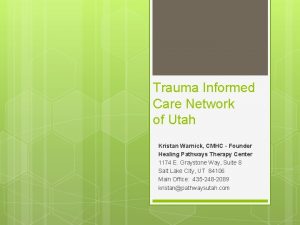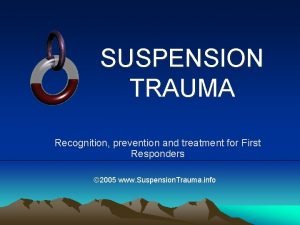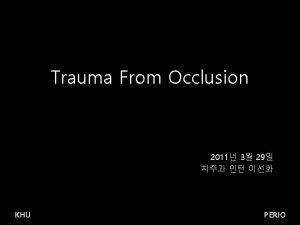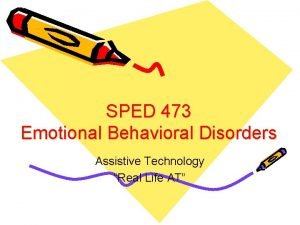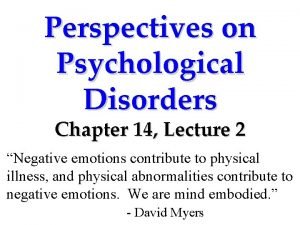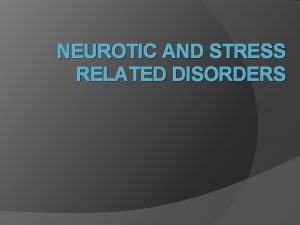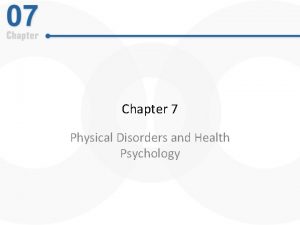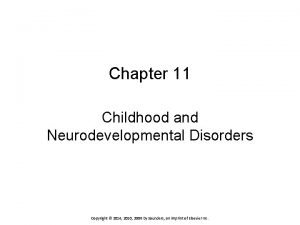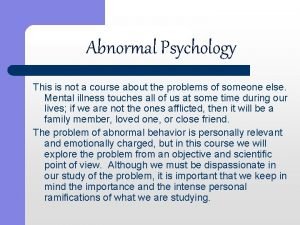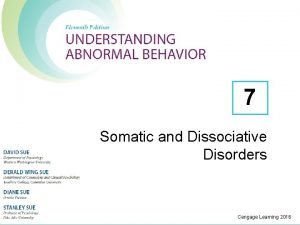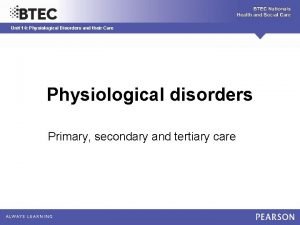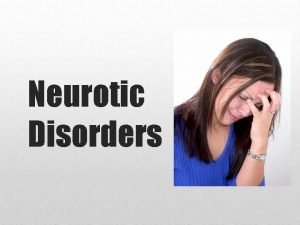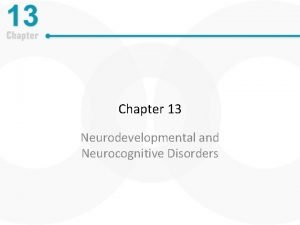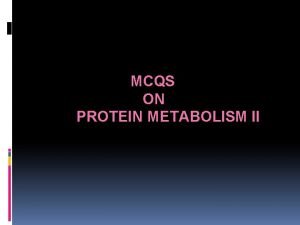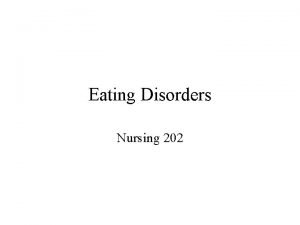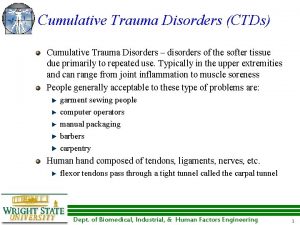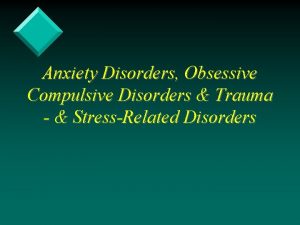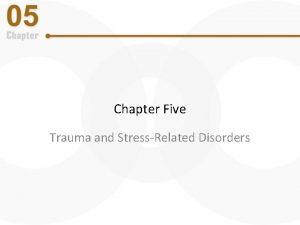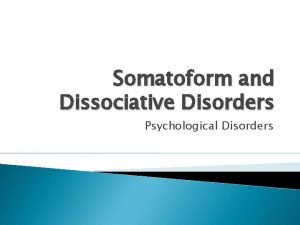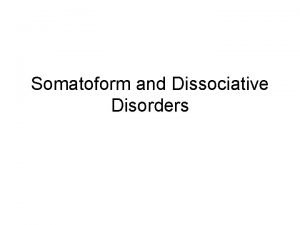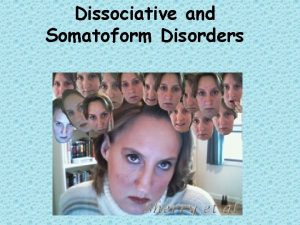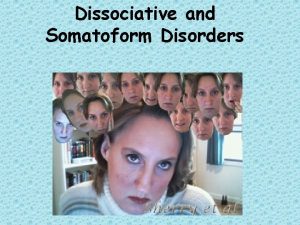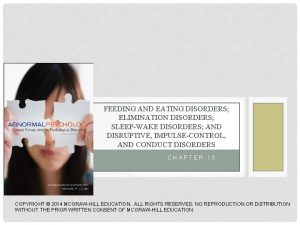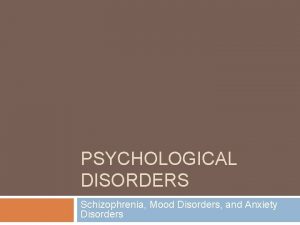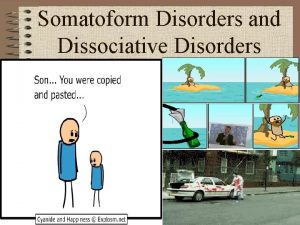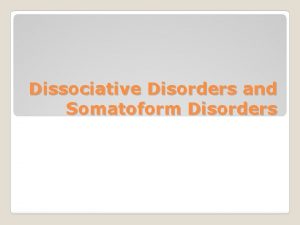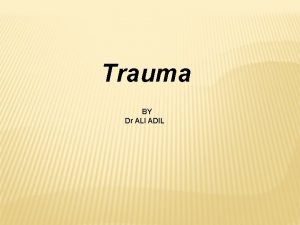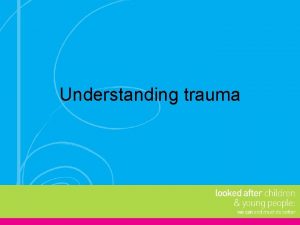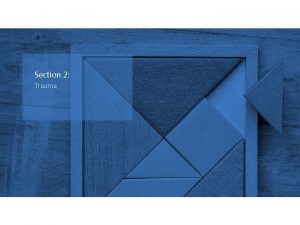Trauma Disorders and Treatment What is Trauma 1

































- Slides: 33

Trauma Disorders and Treatment What is Trauma? 1. The Stress Response: Hypothalamus- “Fight or Flight” overreactive Constant Hypervigilance Avoidance of Stimuli reminders Ruminative Thoughts/Images of Trauma Hippocampus: Memory Trauma: creates Flashbulb memories “Stuck in Time ` Flashbacks Re-living Traumatic events Hallucinations/Delusions Adrenals: Cortisol and Epinephrine overload © Cengage Learning 2016

PTSD Case Examples • Soldiers in War • Adult PTSD • https: //www. youtube. com/watch? v=-Fc 6_a. Tn. RXQ • Childhood Abuse Case: Patricia © Cengage Learning 2016

Trauma- and Stressor-Related Disorders • Types of disorders: • Adjustment Disorder • Acute stress Disorder • Post-traumatic stress Disorder • Complex PTSD: newly researched dx; childhood or chronic trauma © Cengage Learning 2016

Trauma- and Stressor-Related Disorders © Cengage Learning 2016

Trauma-Related Disorders • Typical outcomes after exposure to traumatic incidents: • Resilience • Recovery • Initial distress with symptom reduction over time • Delayed symptoms: Case of Incest • Few initial symptoms • Increasing symptoms over time • Chronic symptoms © Cengage Learning 2016

College Student’s Lifetime Exposure to Traumatic Events © Cengage Learning 2016

General Population: Traumatic Events Associated with ASD and PTSD • Combat • Sexual assaults • Violent crime or domestic violence • Sexual harassment • Natural disasters • Car accidents or work-related accidents © Cengage Learning 2016

Factors Increase Risk of trauma • Factors associated with increased risk • More severe physical injuries • Stroke or injury to the head or extremities • Major burn injuries • Rape or sexual assault • Intentional trauma/ Hx of Trauma • Close relationship with the perpetrator of sexual assault © Cengage Learning 2016

Additional Risk Factors • Existing Mood Disorder Dx • Anxiety and Depression, Hostility, and Anger • Hx of Trauma/ current PTSD dx • Negative/Anxious expectations/events © Cengage Learning 2016

Sociocultural Dimension of trauma • Ethnic differences • Different exposure to previous trauma • Non. Anglo-Amer – more somatic/disassoc>avoidance/numbing • Gender Differences: Women are twice as likely as men to suffer a trauma-related disorder • Female police officers less likely than civilian women to have PTSD symptoms • Why? © Cengage Learning 2016

Resiliency in midst of major Stressors • Factors that create “hardiness” or “resiliency” • Social Support • Strong Family Network • Religiosity/ Spirituality • Social Skills/bonding • Sense of Purpose • Sense of Humor • Hx of Secure Attachment with Parent © Cengage Learning 2016

Lifetime Prevalence of Exposure to Stressors by Gender and PTSD Risk © Cengage Learning 2016

Biopsychosocial Model for PTSD © Cengage Learning 2016

Medication Treatment for Trauma • Antidepressants • Effective in fewer than 60 percent of individuals • Only 20 -30 percent show full recovery • D-cycloserine (Seromycin – antibiotic tx Tuberculosis) • Mixed results • Prazosin (hypertension medication)-blocks sympathetic ns • Propranolol (beta-blocker) – blocks sympathetic ns • may offer little benefit © Cengage Learning 2016

Anxiety Management Techniques • Diaphragmatic Breathing • https: //www. youtube. com/watch? v=g. Akjx 25 o 4 e. I • Mindfulness Exercise • Body Scan • Progressive Relaxation • Safe Place Visualization © Cengage Learning 2016

Psychotherapy for Trauma • Prolonged exposure therapy (PE) • Involves exposure to trauma-related cues • Case Example: Incest Case (handout) • Goal: Reduce Anx/Avoidance assoc with Trauma cues • Cognitive-behavioral therapy (CBT) • Involves identifying and challenging dysfunctional cognitions © Cengage Learning 2016

Psychotherapy treatments • Eye movement desensitization and reprocessing (EMDR) • Nontraditional therapy • Involves visualizing traumatic experience while following a therapist’s fingers moving side to side • Class Demonstration: “Tapping” – Lateral stimulation © Cengage Learning 2016

Group Work: Case Analysis • Case of Annie • Identify Stressor(s) • Identify Symptoms and Diagnosis • How can exposure therapy be implemented in this case? © Cengage Learning 2016

Psychological Factors Affecting Medical Conditions • Chronic Stress • Chronic Illnesses: • Cardiovascular Disease; • Heart Attack • Strokes • Atherosclerosis © Cengage Learning 2016

Coronary Heart Disease • Stress Response: • Epinephrine • Lack of Recovery of Blood Vessels- creating pits/plaque build up • Cardiac arteries narrow • Results in complete or partial blockage of flow of blood and oxygen to heart • Some risk factors for Heart Disease • Poor eating habits • Obesity and lack of physical activity • Hypertension • Stress • Depression © Cengage Learning 2016

Atherosclerosis © Cengage Learning 2016

Hypertension • Strokes : a leading cause of death • Symptoms are difficult to recognize : “silent killer” • Related to Chronic Stress • Poor Coping • Hostility/Unexpressed Anger highly increases risk • Stress-Management key part of tx © Cengage Learning 2016

Types of Headaches • Migraine headaches • Result from constriction of the cranial arteries • Pressure on nearby nerves produces moderate to severe pain • Often accompanied by nausea and vomiting • Tension headaches • Stress creates a prolonged contraction of scalp and neck muscles • Results in vascular constriction and steady pain © Cengage Learning 2016

Cluster Headaches • Excruciating stabbing or burning sensations located in the eye or cheek • Pain so severe that 55 percent report suicidal thoughts • Attacks have a rapid onset • 15 minutes to three hours in duration • End abruptly • Headaches preceded by aura in about 20 percent of cases © Cengage Learning 2016

Asthma • Chronic inflammatory disease of the lungs • Stress or other triggers cause excessive mucus secretion • Spasms and swelling of the airways, which reduces the amount of air that can be inhaled • Symptoms range from mild to severe © Cengage Learning 2016

An Asthma Attack © Cengage Learning 2016

Asthma Prevalence © Cengage Learning 2016

Stress and the Immune System • Stress – shuts off the long-term survival fx and focus on immediate survival • Purpose – survive acute physical stressors • Appears to decrease immune system’s efficiency • Results in more susceptibility to chronic disease • Stress response involves release of hormones (such as cortisol) that impair immune functioning • Chronic stress accelerates disease progression © Cengage Learning 2016

Etiological Influences on Physical Disorders • Biological dimension • Stressors can dysregulate physiological processes in the brain and body • Release of norepinephrine, and cortisol – shuts down immune fx, rest fx, digestive fx, long-term health • Early environmental influences may produce changes in stress-response systems • Negative Parental Factors – unpredictability, safety © Cengage Learning 2016

Psychological Dimension • Psychological and personality characteristics can influence health status • Positive emotions help regulate stress reactions: Optimism, social support, active coping • Negative emotions accentuate the stress response; anxiety/depression increase risk of death • Commitment, control, and openness to challenge associated with thriving through stressful situations: “hardiness” © Cengage Learning 2016

Sociocultural Dimension to Health • Women are more likely to be impacted by stress • Due to care-giving role for children, parents, and partners • More likely to live in poverty • Exposure to racism and discrimination • Can Create PTSD sx • Coping skills, resources, social support mitigate vascular reactivity to racism © Cengage Learning 2016

Treatment of Stress-Related Disorders • Relaxation training • Learn to relax muscles of the body under almost any circumstances • Biofeedback training • Learn to voluntarily control physiological processes in order to improve physical or mental health • Examples: heart rate, blood pressure © Cengage Learning 2016

Review • What do we know about disorders caused by exposure to specific stressors or traumatic events? • In what ways can stress affect our physical health? © Cengage Learning 2016
 Trauma awareness and treatment center utah
Trauma awareness and treatment center utah Suspension trauma treatment
Suspension trauma treatment Trauma from occlusion treatment
Trauma from occlusion treatment Unit 14 health and social care diabetes
Unit 14 health and social care diabetes Bipolar and other related disorders
Bipolar and other related disorders Bipolar and other related disorders
Bipolar and other related disorders Assistive technology for emotional and behavioral disorders
Assistive technology for emotional and behavioral disorders Puberty and autism spectrum disorders
Puberty and autism spectrum disorders Axis 1 and axis 2 disorders
Axis 1 and axis 2 disorders Neurotic, stress-related and somatoform disorders
Neurotic, stress-related and somatoform disorders Chapter 8 skin disorders and diseases review questions
Chapter 8 skin disorders and diseases review questions Physical disorders and health psychology
Physical disorders and health psychology Chapter 6 musculoskeletal system
Chapter 6 musculoskeletal system Chapter 46 digestive and endocrine disorders
Chapter 46 digestive and endocrine disorders Types of somatic disorder
Types of somatic disorder Chapter 29 endocrine and metabolic disorders
Chapter 29 endocrine and metabolic disorders Chapter 21 mental health diseases and disorders
Chapter 21 mental health diseases and disorders Personality disorder vs mental illness
Personality disorder vs mental illness Chapter 18 eating and feeding disorders
Chapter 18 eating and feeding disorders Chapter 17 reproductive system diseases and disorders
Chapter 17 reproductive system diseases and disorders Chapter 15 nervous system diseases and disorders
Chapter 15 nervous system diseases and disorders Chapter 15 anxiety and obsessive-compulsive disorders
Chapter 15 anxiety and obsessive-compulsive disorders Chapter 11 childhood and neurodevelopmental disorders
Chapter 11 childhood and neurodevelopmental disorders What conditions do fungal organisms favor for growth
What conditions do fungal organisms favor for growth Little albert
Little albert Somatic symptom and related disorders
Somatic symptom and related disorders Physiological disorders and their care
Physiological disorders and their care Neurotic stress-related and somatoform disorders
Neurotic stress-related and somatoform disorders Elsevier
Elsevier Chapter 10 nail disorders and diseases
Chapter 10 nail disorders and diseases Cardiovascular system diseases and disorders chapter 8
Cardiovascular system diseases and disorders chapter 8 Neurocognitive disorder
Neurocognitive disorder Protein metabolism mcq
Protein metabolism mcq Hypothalamus and eating disorders
Hypothalamus and eating disorders
